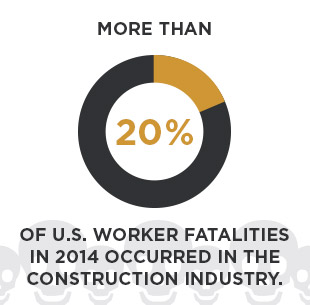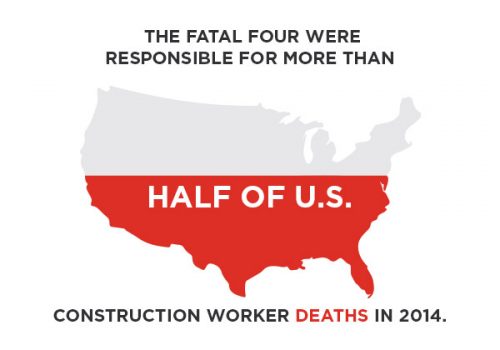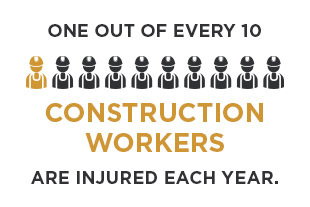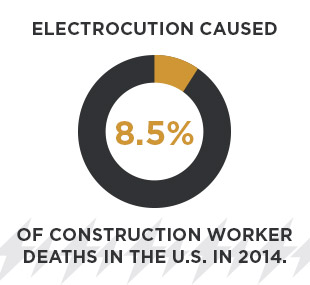Contact Clark Contractors, Inc.
Construction Site Safety Tips
Construction is well known as one of the most dangerous jobs in America. More than 20 percent of U.S. worker fatalities in 2015 occurred in the construction industry. That’s approximately one in five worker fatalities.
The U.S. Occupational Safety and Health Administration (OSHA) has put many safety regulations in place for construction sites. Its efforts have reduced workplace fatalities by more than 66 percent since 1970. Worker injuries and illnesses have also been reduced from 10.9 per every 100 workers to only 3.3 per every 100 workers. All construction sites are required by law to follow OSHA’s safety regulations.
However, statistics show that OSHA regulations alone are not enough to keep construction workers safe on the job. It’s still very important for all construction workers to be vigilant and take extra steps to keep themselves and their fellow workers safe.
Top Construction Site Dangers
Falls are the top cause of death on construction sites, accounting for close to 40 percent of all worker deaths in the U.S. construction industry in 2014. Other common causes of death on construction sites include:
- Electrocution
- Being struck by an object
- Being caught in an object or between two objects
These four causes are so common that they are referred to by OSHA as the Fatal Four. The Fatal Four were responsible for more than half of U.S. construction worker deaths in 2014. Eliminating the Fatal Four from construction sites would save the lives of approximately 508 American construction workers per year.
When it comes to injuries on construction sites, workers tend to injure their backs more than any other body part. One out of every 10 construction workers are injured each year, and most of them miss at least 31 days of work as a result of their injuries. Some common causes of injuries to construction workers include:
- Repetitive motion
- Incorrect or reckless use of machinery and tools
- Trench or scaffolding collapse
- Electric shock
- Failure to use protective equipment
Don’t become another statistic. Follow these construction site safety tips, in addition to OSHA regulations, to help keep yourself and your job site safe.
Construction Site Dress Code
Protecting yourself from injury on a construction site starts with choosing the right wardrobe. Follow these dress-code tips for construction workers to stay safe on the job:
- Apparel: Wear shirts with sleeves, and long pants that are free from rips and holes. Avoid shorts and never wear skirts or dresses. Wear highly visible clothing when working around heavy vehicles. Remember to dress appropriately for the weather in your area. Construction workers often work outside and need to be prepared for very hot or cold temperatures.
- Footwear: Do not wear open-toed shoes. Sturdy work boots are best to protect your feet from falling objects or stepping on sharp objects like nails. Wear nonslip shoes in a dusty or slippery environment. Protective footwear may be required if you are working with toxic substances.
- Accessories: Avoid any kind of dangling jewelry like earrings, necklaces and bracelets.
- Hair: Tie back long hair or keep your hair cut short.
- Safety equipment: Always wear the necessary protective gear for your job, including hard hats, safety glasses, masks, earplugs, gloves and fall harnesses. Before using your safety equipment, remember to inspect it for cracks, holes or any other defects.
Safe Lifting on a Construction Site
Proper lifting technique is essential to protecting your back and shoulders from injury on the job. Follow these tips to safely lift heavy objects and avoid injury:
- Always lift with your legs, not your back.
- Bend at the knees, not the waist.
- Keep your back straight. Avoid bending or twisting your back while lifting.
- Only lift objects that are close to your body. Keep your elbows close to you and avoid reaching.
- Lift objects using proper handholds, like handles, slots or holes. If no handholds are available, you can use suction devices to create a temporary handle.
- Keep heavy objects at power zone height, which is about mid-thigh to mid-chest.
- When lifting objects that weigh more than 50 pounds, ask for help or use mechanical means like forklifts or duct lifts.
- Use ramps or lift gates to lift heavy loads onto trucks.
- Take a break from lifting if your muscles start to feel sore.
Vehicle & Machinery Safety on Construction Sites
Many construction-site injuries are caused by reckless use of machinery. Follow these safety tips in construction work to properly operate large vehicles, heavy machinery and other equipment.
Stay safe while getting on and off of equipment Most injuries to equipment operators, forklift drivers and truck drivers occur while doing this. Follow these steps to properly climb on or off of a large vehicle or other piece of equipment and protect yourself from injury:
- Check your gloves and boots Remove any mud or dirt from your gloves and boots before climbing on or off of equipment. Be sure to use high grip gloves so you have a secure grip.
- Use handholds and footholds: Use large handholds and footholds when available. Securely grip handholds using your entire hand and step on footholds with your whole foot. If no footholds are available, use a stepladder.
- Use a three-point stance: The three-point stance is most commonly used by offensive linemen in football, but it’s also helpful in construction. First, bend your knees and lean your back slightly forward. Keep one hand on a handhold while you reach up or down with the other hand.
- Keep your hands free. Avoid carrying objects while you are climbing on or off of equipment.
- Don’t jump. When you are exiting a vehicle or machine, lower yourself slowly in a controlled manner. Never jump off.
Wear your seatbelt. OSHA regulations require that all equipment operators wear seatbelts when they are available, but many still neglect to buckle up. If a piece of equipment tips over, your seatbelt can save your life by preventing you from falling out and getting crushed, or mousetrapped between the machine and the ground.
You should wear your seatbelt even if the cab door is closed, as it can keep you from bouncing around inside. Your seatbelt can also help you control the equipment in the event of an upset.
Protect yourself and others while loading and unloading materials. Failing to properly load and unload materials from a vehicle or machine can pose a danger to everyone on a construction site. Not lifting properly can injure your back and shoulders, and a rollover can harm you or anyone nearby. Follow these tips to keep everyone safe while loading and unloading equipment:
- Use proper lifting technique: Follow the same tips for lifting heavy objects outside of a vehicle or machine. When reaching for materials in a cramped space, be sure to lift from a kneeling position. If you are pushing or pulling objects, it’s best to do this from a crouching position. Use forklifts and ramps whenever possible to reduce strain on your back and shoulders.
- Avoid rollover: When loading or unloading materials using a ramp, there is always the risk of a rollover. To avoid injury, make sure the ramp is straight and your materials are centered on the ramp. Be sure to clear the ramp before turning. Use a spotter for guidance, but keep others away from the sides of the equipment.
Avoid an accident while backing up Most construction vehicles and machines are equipped with backup alarms to warn workers when they are reversing. However, in a noisy construction environment these alarms are not always sufficient. Follow these steps to properly back up a large machine or vehicle and protect yourself and others:
- Clear the area. Keep other workers away from the equipment operating area, and be sure to use the horn to warn anyone nearby before backing up.
- Check your mirrors. Make sure your mirrors are clean and adjusted to best show the area behind the equipment. Use wide-angle mirrors if possible.
- Look behind you. Always check the back of any vehicle or machine before backing it up. It’s best to get out and look instead of depending on the mirrors alone.
- Use a spotter. If your vision is obstructed, ask a spotter to help you back up, but make sure the spotter stays clear of the back of the vehicle or machine.
Safety Tips When Working on Scaffolding & Trenching
Most injuries and deaths on U.S. construction sites are caused by falls, either from high platforms or into deep holes. It is extremely important to stay safe around scaffolding and trenches to avoid falling.
Both scaffolding and trenches can also collapse, causing injuries and fatalities. This most often occurs when the scaffolding or trench is not constructed or used properly. Follow these tips to protect yourself and others while working on a construction site with scaffolding or trenches.
- Always wear a safety harness when working on a scaffold.
- Check with your supervisor to ensure that the scaffold has been inspected.
- Never work on a scaffold that doesn’t have a guardrail in place.
- Never work on an incomplete scaffold.
- Never work in a trench that is not properly lit.
- Never enter a trench that doesn’t have a protective system in place, like a fence or guardrail.
- If a trench does not have a protective system, or the system is broken or damaged, report it to your supervisor immediately.
- Make sure you know the nearest exit or escape route in case of emergency.
Safety Tips for Construction Site Electrical Equipment
Electrocution caused 8.5 percent of construction worker deaths in the U.S. in 2014. Construction workers should be extra careful when working with electricity. Follow these tips to learn how to be safe on a construction site that uses electrical equipment or cables:
- Wear the proper protective gear when working with electrical equipment.
- Check any electrical equipment for wear and tear before use.
- Always follow the safety precautions listed on the equipment.
- Make sure electrical cables are protected and grounded, and that the power supply uses an earth leakage circuit breaker.
- Keep all electrical equipment away from water.
Ladders and Stairways on Construction Sites
In an average year, falls from ladders and stairways cause approximately 36 deaths and nearly 25,000 injuries on U.S. construction sites. These injuries result in more than 11,000 missed workdays per year. Follow these tips to stay safe while working on ladders and stairways on a construction site:
- Inspect ladders and stairways for defects before use.
- Make sure the ladder or stairway is not greasy or slippery.
- Check your gloves and boots for dirt, mud or any other slippery substance before using a ladder or stairway.
- Always use handrails when available.
- Always use a ladder that is long enough to safely reach your work area.
- Never exceed the weight limit of a ladder.
- Keep metal ladders away from any sources of electricity.
Hazardous Materials on Construction Sites
It is important to follow all required safety regulations when handling hazardous materials, like toxic chemicals, on a construction site. OSHA requires that all potentially hazardous substances are provided with a Material Safety Data Sheet (MSDS), which lists the proper procedures for handling and working with the substance. The MSDS includes information like melting and boiling points, toxicity, reactivity, health effects, first-aid procedures, spill and leak procedures, proper storage and disposal, and any recommended protective equipment. Before working with any potentially hazardous substances, be sure to familiarize yourself with its MSDS.
You should also know where the nearest first-aid kit can be found in case of injury. This first-aid kit must include treatment for minor burns and cuts. If there is no first-aid kit available, inform your supervisor immediately.
Fire Safety Procedures on Construction Sites
Construction sites often contain flammable materials such as combustible chemicals, as well as electrical equipment and welding operations. This is why it’s extremely important to take the proper safety measures to prevent fires on a construction site. Open flames should be kept away from construction sites at all times.
You should always know the nearest escape route in case of a fire or other emergency. It’s also a good idea to know where the nearest fire extinguisher is located, and know how to use it. Your supervisor should be able to train you on how to correctly use a fire extinguisher.
Construction Site Safety Checklist
Use the following safety checklist to ensure that your construction site meets the proper safety standards. Contact your supervisor about any item on the list that is not checked. Here’s how to make a construction site safe:
- Can you reach your work area safely?
- Are all roads, passages, stairways and ladders in good condition?
- Are there guardrails in place on all scaffolds?
- Are all working structures stable and properly braced?
- Are all trenches and holes clearly marked and protected by fences or guardrails?
- Are all hazardous materials stored properly and safely?
- Is your work area clean and adequately lit?
- Is all waste being disposed of properly and safely?
At Clark Contractors, we know the importance of safety on a construction site. We offer cost-effective, professional project management and consulting services throughout western/central Pennsylvania and northern Maryland. You can count on us to provide comprehensive construction service that respects your budget and timeline. For more information, or to get started on your next construction project, contact us or call us at 814-623-9400.







